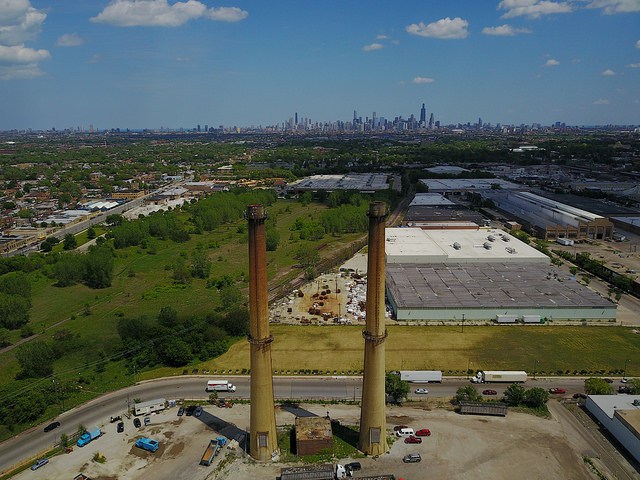Post
REPORT | Rationalising Land Use in the Green Belt
17 Apr 2018
On 10 April the Society's 'Planning for 10 Million Londoners' series touched on one of the most constantly controversial issues in London's planning - the preservation or otherwise of the Green Belt. Colin Wilson of the GLA stuck his head over the parapet; Ben Taylor of Hawkins Brown reports.
Let’s release 3% of the Green Belt. Not the nice parts that people enjoy, just areas already inside the GLA boundary that are unused or cut off by infrastructure and London. Then pockets of virtually abandoned, often contaminated land can be put to better use for housing or industry and London can undo its top button and expand without anyone getting too upset. This is what Colin Wilson argued for in his talk, Rationalising Land Use Allocation in the Green Belt – the latest in the London Society’s Planning for 10 Million series. In a presentation he first gave to the deputy Mayor of London’s office a year ago, Wilson made a pragmatic and insightful case for re-examining parts of the Green Belt that fall short of the green and pleasant land held within the public imagination and which could offer a more beneficial purpose. This was backed up by an account from Ismail Mulla of Enfield Borough Council on how the local authority was preparing for the growing population challenges ahead.
The talks were framed around the Upper Lea Valley Opportunity Area, where we were shown a host of run-down areas of outer London that, Wilson argues, could have far greater social value if not constrained by Green Belt legislation. And it’s difficult to disagree. As the population of London creeps towards the 10 million mark, these corners of neither suburb nor countryside are growing increasingly contentious. Moreover, billions are being spent by the public on Crossrail 1 and 2, planned to extend along the Lea Valley deep into the Green Belt. The outcome is set to be that a few areas of scrubland are set to become enviably well-connected. So how, we are asked, can we justify this investment if unused areas along its route are prohibited from being developed?
Wilson’s most pertinent insight, however, was to remind us that the Green Belt should be understood as a mechanism for urban containment, rather than as a landscape in its own right. This certainly resonated with my own reflection on the Green Belt. Readers of the London Society blog will probably be aware that the stated function of the Green Belt is to keep the land within ‘permanently open’. They might be less aware that there is no firm definition for what openness means, or what makes it such an axiomatic good that it should form the basis for urban containment. One would be forgiven for seeing it as a straightforward spatial attribute – after all, who doesn’t want the open countryside to be protected? Though consider, as Wilson encourages us to do, the landscapes that are preserved within the Green Belt by virtue of their ‘openness’. Parks and woodland, yes – but also industrialised agriculture, golf courses, utilities and infrastructure, many of which are significantly environmentally degraded and make little societal contribution. Perhaps this is why the Green Belt has proven such an extraordinarily popular and successful policy (at least within its own terms). If this wide range of environments can be comprehended as a single ‘open’ landscape, it can be conceived of as a single place, the entirety of which will be under threat by any form of development. Through his examples, Wilson convincingly dispels this commonplace misconception: selectively and strategically changing the use of permanently spoiled (albeit ‘open’) areas does not mean the complete erosion of the countryside.
It has been over 50 years since the Green Belt was introduced, Wilson observes – is it still the same place as it was back then? Indeed, were we to introduce the Green Belt today, would we protect the same areas? Presumably not was the clear message of the evening, so what do we do about it? This is where questions remained. Both talks were framed heavily in relation to the new London Plan, but as a chapter of planning policy the Green Belt is enacted by national government, to which virtually no reference was made by either speaker. So for all the persuasive points for making London work for 10 million, how do we find the political drive to enact it? This revealed a more conspicuous absence in the talk – Wilson’s refrain from making a direct stance on what the Green Belt and London’s periphery should be. While at pains to emphasise that only dilapidated parts of the Green Belt need be reallocated to meet London’s growth, this approach overlooks the fact that environmental degradation of London’s edge is often a direct result of Green Belt policy. There are good arguments for maintaining London’s urban containment, as there are for relaxing it. However, the Green Belt and its central tenet of openness is a bizarre and damaging means by which to achieve it. Retreating from this reality limits any plan for outer London to temporary fixes rather than forward-looking strategies.
Though both talks had some arresting details and vital questions, the take from the evening was not unfamiliar: the Green Belt basically works, except for when it doesn’t. Chatting with other attendees over drinks at the end, the parting feeling was something like the deflation of seeing a toy in a shop window you want but can’t have. Hearing his resigned sigh that none of what he presented was being adopted into the new London Plan, you got the feeling Colin Wilson felt the same way.
To be kept up to date with future London Society events, sign up for our free newsletter.
